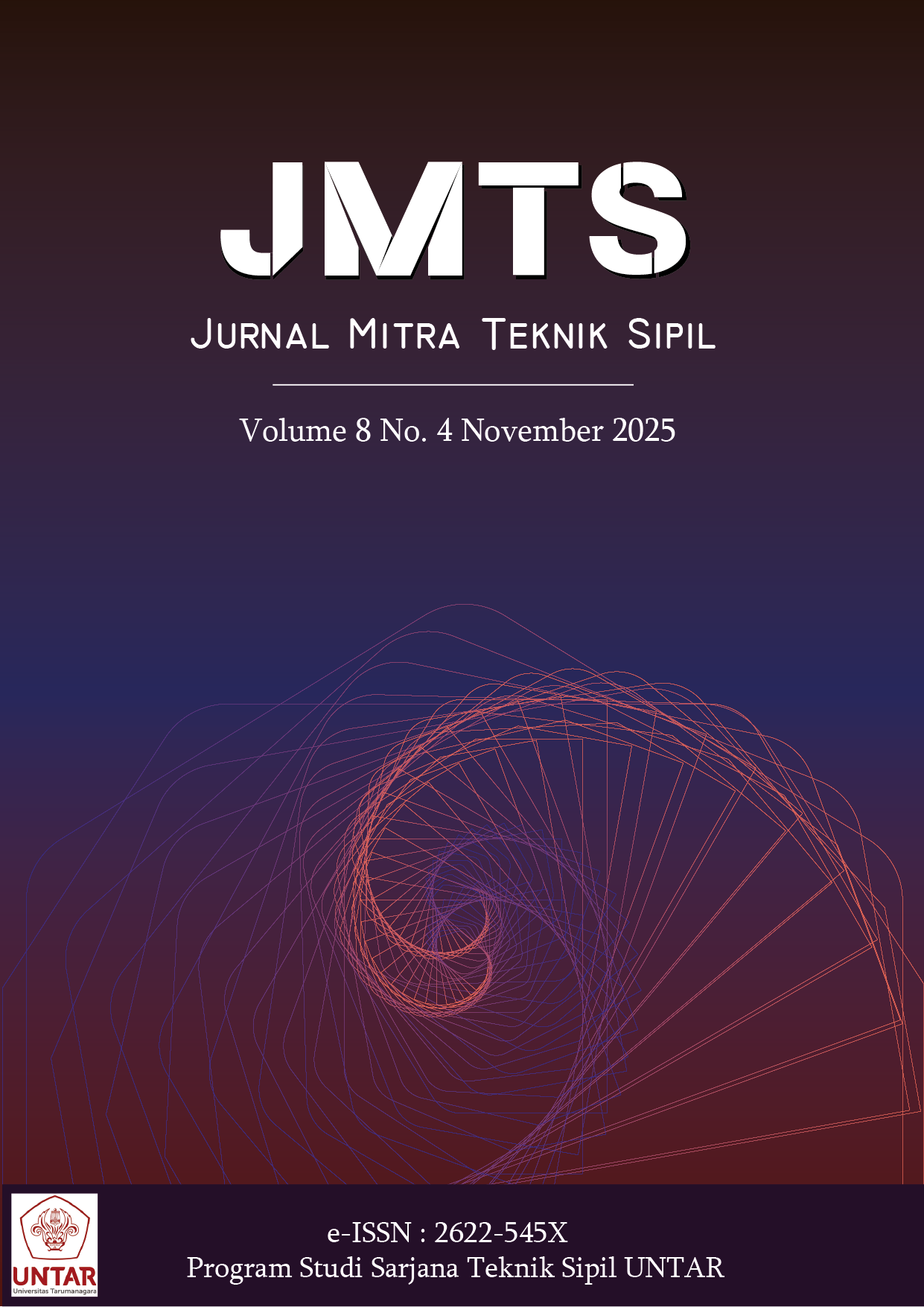PERHITUNGAN MANUAL DAN PEMODELAN ELEMEN HINGGA TRIAL TEST DYNAMIC COMPACTION BANDARA YOGYAKARTA KULON PROGO
Main Article Content
Abstract
ABSTRACT
The new airport in the south of Yogyakarta is an important air transport facility. Geologically, the airport is located on a low-density sandy soil. Low density is prone to liquefaction hazards so it is necessary to improve the soil to increase the density of sandy soil. Land improvement to reduce liquefaction potential on sandy soil can be done by Dynamic Compaction (DC) method. This method is applied to non-residential land by dropping steel tampers from a certain height to achieve a specified density. As an alternative to non-cohesive soil improvement, DC offers cost and time efficiency and is relatively easy to apply with simple technology compared to methods such as vibroflotation. In the planning, finite element modelling (FEM) was used as an advanced study to analyze key parameters (tamper weight, drop height, empirical coefficient “n”, and energy by soil type). The aim was to validate the manual calculation results in the Trials Area before full-scale compaction. The manual calculation served as the main design reference, while the FEM served as an additional verification. Recording the pre- and post-compacting soil conditions was essential to calculate the percentage of design errors.
ABSTRAK
Bandara udara baru di Selatan kota Yogyakarta merupakan fasilitas penting dalam transportasi udara. Secara geologi lokasi bandara ini terletak diatas tanah pasir dengan kepadatan rendah. Kepadatan rendah sangat rentan terhadap bahaya likuefaksi sehingga perlu perbaikan tanah untuk meningkatkan kepadatan tanah pasiran. Pematangan lahan untuk mengurangi potensi likuefaksi pada tanah pasir dapat dilakukan dengan metode Dynamic Compaction (DC). Metode ini diterapkan pada lahan yang tidak ditinggali penduduk dengan menjatuhkan tamper baja dari ketinggian tertentu guna mencapai kepadatan rencana. Sebagai alternatif perbaikan tanah non-kohesif, DC menjanjikan biaya dan waktu yang lebih efisien, serta relatif mudah diaplikasikan dengan teknologi sederhana dibandingkan metode pemadatan lain seperti vibroflotation. Dalam perencanaannya, pemodelan elemen hingga (FEM) digunakan sebagai studi lanjutan untuk menganalisis parameter kunci (berat tamper, tinggi jatuh, koefisien empiris 'n', dan energi berdasarkan jenis tanah). Tujuannya adalah memvalidasi hasil perhitungan manual di Area Percobaan sebelum pemadatan skala penuh. Perhitungan manual menjadi acuan desain utama, sedangkan 3D FEM berfungsi sebagai studi lanjutan. 3D FEM dilakukan untuk mempelajari perilaku tanah pasiran saat dipadatkan, memperkirakan kedalaman pemadatan, interaksi antar titik pemadatan. Pencatatan kondisi tanah pra dan pasca penumbukan sangat penting untuk menghitung persentase kesalahan desain.
Article Details

This work is licensed under a Creative Commons Attribution-NonCommercial-ShareAlike 4.0 International License.
This work is licensed under Jurnal Mitra Teknik Sipil (JMTS) Creative Commons Attribution-ShareAlike 4.0 International License.References
Bowles, J. E. (1988). Foundation Analysis and Design (4 ed.). McGraw-Hill. https://books.google.co.id/books?id=eNxRAAAAMAAJ
Das, B. M., Endah, N., & Mochtar, I. B. (1995). Mekanika tanah. Erlangga, Jakarta.
Fauziek, M., & Suhendra, A. (2018). Efek dari Dynamic Compaction (DCdc) terhadap Peningkatan Kuat Geser Tanah. JMTS: Jurnal Mitra Teknik Sipil, 1(2), 205. https://doi.org/10.24912/jmts.v1i2.2681
Finno, R. J., & Calvello, M. (2005). Supported Excavations: Observational Method and Inverse Modeling. Journal of Geotechnical and Geoenvironmental Engineering, 131(7), 826–836. https://doi.org/10.1061/(ASCE)1090-0241(2005)131:7(826)
Gouw, T.-L. (2018). Proposed design guideline of dynamic compaction for practicing engineers. Geotechnical Engineering, 49(2), 32–40.
Gouw, T.-L. (2022). Investigation of Dynamic Compaction and Vibro-compaction to Mitigate Liquefaction: A Case Study. Indonesian Geotechnical Journal, 1(2), 38–49. https://doi.org/10.56144/igj.v1i2.16
Hajivand, R. D., Zamani, M. A. M., Knez, D., & Kazemi, K. (2023). Comparing Several Different Numerical Approaches for Large Deformation Modeling with Application in Soil Dynamic Compaction. Transportation Infrastructure Geotechnology, 10(5), 913–939. https://doi.org/10.1007/s40515-023-00278-2
Jiang, C., Ge, Y., Wang, B., Zhang, L., & Liu, Y. (2021). Impact of the High‐Energy Dynamic Compaction by Multiple Compactors on the Surrounding Environment. Advances in Civil Engineering, 2021(1). https://doi.org/10.1155/2021/6643064
Koohsari, H., Alielahi, H., Najafi, A., & Adampira, M. (2023). The Application of Artificial Intelligence Methods on the Optimizing Improvement Depth of Dynamic Compaction. https://doi.org/10.21203/rs.3.rs-2369466/v1
Li, W., Gu, Q., Su, L., & Yang, B. (2011). Finite element analysis of dynamic compaction in soft foundation. Procedia Engineering, 12, 224–228. https://doi.org/10.1016/j.proeng.2011.05.035
Lukas, R. G. (1995). Geotechnical Engineering Circular No.1, Dynamic Compaction. https://vulcanhammer.net/wp-content/uploads/2017/01/fhwa-sa-95-037.pdf
Ramadan, M. M. (2013). Influence of Construction Processes induced Vibrations on Soil and Adjacent Structures [Tanta University]. https://vulcanhammer.net/wp-content/uploads/2020/03/influenceofconstructioninduced vibrationsonsoilandadjacentstructures.pdf
Sun, Y., Huang, K., Chen, X., Zhang, D., Lou, X., Huang, Z., Han, K., & Wu, Q. (2023). Study on the Reinforcement Mechanism of High-Energy-Level Dynamic Compaction Based on FDM–DEM Coupling. Mathematics, 11(13), 2807. https://doi.org/10.3390/math11132807
Thevanayagam, S., Martin, G. R., Nashed, R., Shenthan, T., Kanagalingam, T., & Ecemis, N. (2006). Liquefaction Remediation in Silty Soils Using Dynamic Compaction and Stone Columns. In Technical Report MCEER-06-0009. https://www.eng.buffalo.edu/mceer-reports/06/06-0009.pdf
Wu, S., Wei, Y., Zhang, Y., Cai, H., Du, J., Wang, D., Yan, J., & Xiao, J. (2020). Dynamic compaction of a thick soil-stone fill: Dynamic response and strengthening mechanisms. Soil Dynamics and Earthquake Engineering, 129, 105944. https://doi.org/10.1016/j.soildyn.2019.105944
Zhou, C., Yang, C., Qi, H., Yao, K., Yao, Z., Wang, K., Ji, P., & Li, H. (2021). Evaluation on Improvement Zone of Foundation after Dynamic Compaction. Applied Sciences, 11(5), 2156. https://doi.org/10.3390/app11052156



